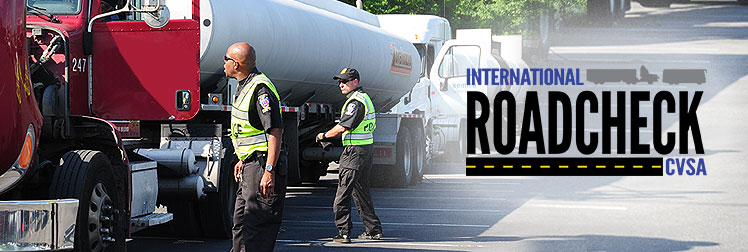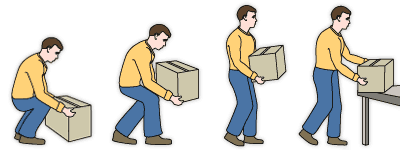|
|
|
Annual Roadcheck Inspection Spree in June, to Focus on Hours Violations

T he Commercial Vehicle Safety Alliance's (CVSA) annual International Roadcheck, a three-day ramp up of truck and bus enforcement across North America, is scheduled for June 5-7, 2018. The focus of the roadcheck will be hours-of-service compliance, partly in accordance with the implementation of the U.S. Department of Transportation's electronic logging device (ELD) mandate. CVSA President Capt. Christopher Turner of the Kansas Highway Patrol says, "The top reason drivers were placed out of service during the 2017 International Roadcheck was for hours-of-service violations.
Although the ELD rule that went into effect on does not change any of the underlying hours-of-service rules or exceptions, the ELD mandate placed a spotlight on hours-of-service compliance. We thought this year would be a perfect opportunity to focus on the importance of the hours-of-service regulations." Inspectors, however, will still perform full Level I inspections, which are the most thorough, on most rigs checked during the inspection blitz. CVSA has said in years past that an average of 15 trucks and buses are inspected every minute across North America during the 72-hour event.
In last year's Roadcheck, 15,000 out-of-service orders were issued. Of those, 12,000 were for vehicle-related violations, and 3,000 were for driver-related violations. Violations related to hours of service and brakes topped the out-of-service infractions. Enforcers in 2017 conducted more than 63,000 inspections during the 72-hour event.
(Source: NLBMDA Workplace Safety & Risk Management Newsletter, May 2018)
|
|
Key Takeaways: OSHA Citation Data for Wiring Methods, Components, and Equipment for General Use
OSHA Standard 1910.305 sets out requirements regarding wiring methods, components and equipment for general use. As part of our annual review of the most recent OSHA citation data for the LBM sector, here are some key takeaways to help focus you on compliance and safety. You may find Standard 1910.305 in its entirety on the OSHA website .
1. Protect all conductors! Conductors entering cutout boxes, cabinets, or fittings must be protected from abrasion, and openings through which conductors enter must be effectively closed. Unused openings must be closed. See 1910.305(b)(1), Conductors entering boxes, cabinets, and fittings.
2. Cover all openings! Pull boxes, junction boxes and fittings must be covered and outlet boxes through which cord pendants pass must have bushings. See 1910.305(b)(2), Covers and canopies.
3. Cover all openings! Flush-mounted snap switches must have faceplates that completely cover the opening and seat against any finished surface. See 1910.305(c)(4).
4. Know when you can use flexible cords! Use the right flexible cords and cables for the job and location. Do not use flexible cords or cables as substitutes for fixed wiring of a structure. See 1910.305(g)(1).
5. Know how to use flexible cords! As a general rule, flexible cords may be used only in continuous lengths without splice or tap. Flexible cords and cables must be connected to devices and fittings so that strain relief will prevent pull from being directly transmitted to joints or terminal screws. See 1910.305(g)(2), Identification, splices and terminations.
6. No live parts exposed! Fixtures, lamp holders, lamps, rosettes, and receptacles may have no live parts exposed to employee contact. Also, fixtures installed in wet or damp locations must be identified for that purpose. See 1910.305(j)(1).
7. Don't use grounding plugs with non-grounding receptacles! Non-grounding-type receptacles and connectors may not be used for grounding-type attachment plugs. See 1910.305(j)(2), Receptacles, cord connectors, and attachment plugs (caps).
8. Know how to weatherproof outdoor receptacles! A receptacle installed outdoors in a location protected from weather must have an enclosure that is weatherproof when the receptacle cap is closed. The weatherproofing requirement differs for receptacles installed in wet locations depending on whether it will be used attended or unattended. If the product plugged into the receptacle will be attended while in use, such as a power tool, the weatherproofing must be effective when the plug cap is removed. See 1910.305(j)(2), Receptacles, cord connectors, and attachment plugs (caps).
(Source: NLBMDA Workplace Safety & Risk Management Newsletter, May 2018)
|
|
|
|
Watch Your Back: The Right Way To Lift Objects

From boxes of paper near the printer to large packages in the mailroom, office settings contain a number of objects - some quite heavy - that require manual lifting. Are you following safe lifting practices?
It's important to know how to lift the right way. According to the 2017 edition of Injury Facts, a National Safety Council chartbook, more than 300,000 cases of sprains, strains or tears resulted in days away from work in 2014. Help protect yourself by following these four steps for safe lifting from the Washington State Department of Labor & Industries:
1.) Size it up. Is the load light enough to be lifted by one person? If not, use a hand truck or ask for assistance. Check the container for exposed nails or staples that could cause injuries, and make sure you have a clear path to where you're moving the load.
2.) Safely lift. If the load can be lifted without assistance, first bring it as close to your body as possible. Lift with your legs - never with your back. Keep your head up and your back straight, and bend at the hips.
3.) Move with care. Keep the load close to your body as you walk, and look ahead to be sure your path remains clear. Shift - don't twist - your body to turn.
4.) Don't just drop it. When you're ready to set down the load, let your leg muscles "carry it down," Washington L&I states. Make sure your fingers and toes are clear of the load before setting it down.
(Source: Safety+Health magazine , May 2018)
|
July 26-29: BMSA's Summer Conference
(Virginia Beach, VA)
September 12-14: Leadership Development Roundtable # 2
(Wilmington Beach, NC)
September 16-18:
CFO Roundtable
(Traverse City, MI)
September 30-October 2: Roundtable #1
(Greenville, NC)
October 11-12: Operations Manager Roundtable A
(Wilson, NC)
October 17-19: NLMBDA Pro Dealer Industry Summit (Chicago, IL)
October 17-19: Roundtable #3 (New Bern, NC)
October 25-26: Operations Manager Roundtable B
(North Charleston, SC)
November 7: BMSA Executive Committee & Board of Directors Meetings
(Columbus, OH)
November 7-8: Ohio Education Summit
(Columbus, OH)
November 15-16: Sales Manager Roundtable
(Charleston, SC)
|
|